Nuraghe are unique to Sardinia, and if you are planning on visiting the island, you really should make a point to visit at least one. There are many scattered around, and if you drive around the island you will often spot them not far from the side of the street. Some easy to reach; others not yet fully excavated and still surrounded by an aura of mystery, all of them equally interesting.
In this post, I highlight the most famous ones. But before I do so, let me give you a bit of an introduction.
*A quick note to say that nuraghe can be spelt either as nuraxi (singular) or nuraxis, which is the Sardinian word, or as nuraghe and nuraghi, in Italian. I will be using both words throughout this post.
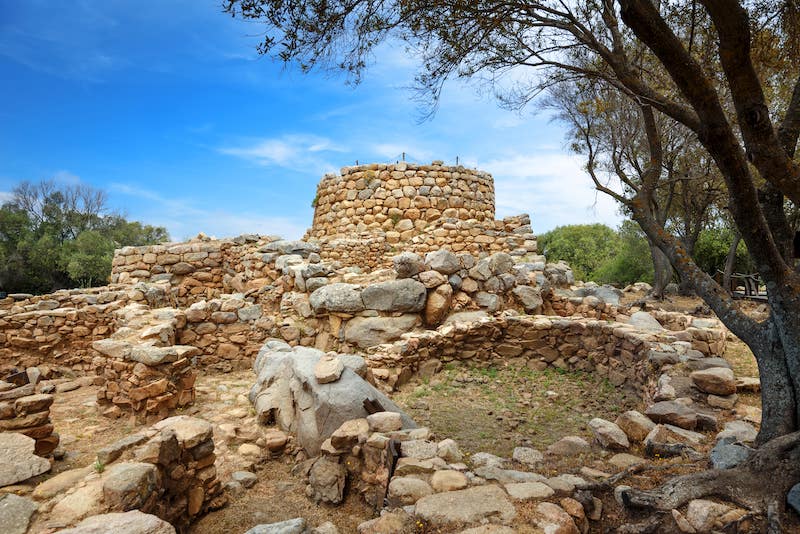
Table of Contents
What Is A Nuraghe?
First things first; what is a nuraghe? Nuraghe are ancient megalithic edifices found exclusively on the Italian island of Sardinia— and nowhere else in the world! These truncated cone stone structures were built by the Nuragic civilization between 1900 and 730 BC. While there are still 7,000 nuraghes found on the island, it is estimated that there were once more than 10,000 in total.
While there is currently no consensus among the experts as to the function of nuraghes, it has been hypothesized that they were either the homes of rulers or military strongholds, or perhaps religious temples or meeting halls. Maybe they functioned as all of the above!
That being said, there are actually five different types of nuraghe in Sardinia.
First, there are the protonuraghe. They are the most archaic and have an irregular shape and layout. Then there are the mixed-nuraghe, which evolved slightly from the protonuraghe designs. Next, the single tower nuraghe, which are the most predominant type of nuraghe you will see in Sardinia.
The single tower has a conical shape that has been likened to a beehive. Then the “tancadu” nuraghe was developed, which included the addition of a circular building added to the main tower, with walls connecting the two. Lastly, the polylobed nuraghe, also referred to as the Nuragic royal palaces. This type of nuraghe looks more like a fortress or a castle, with an elaborate design and lots more buildings connected to the towers.

Who Were The Nuragic People?
The Nuragic civilization lived in Sardinia from the Bronze Age up to the Roman colonization. While there are no written records of this civilization, the only written information has been derived from Greek and Roman literature. However, such literature has been viewed and regarded as more mythological than historical. After all, the Greeks and Romans sure liked their heroes, gods, and giants!
In fact, early Greek historians believed that nuraxis might have been built by Daedalus— the mastermind architect behind the labyrinth in Crete for the Minotaur. It was hypothesized that after he finished building the labyrinth, he moved to Sicily, then on to the island of Sardinia, where he got to work building the various towers. Fact or fiction? Who’s to say!
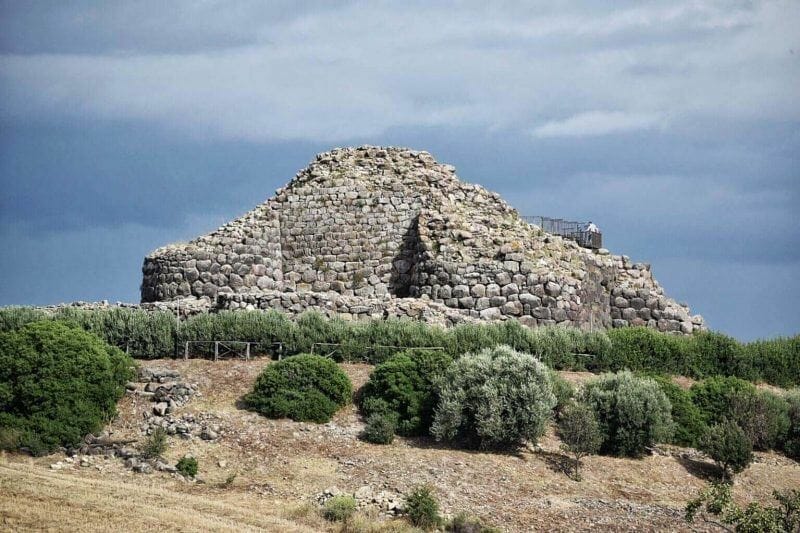
Which Nuraghe Should You Visit In Sardinia?
Since the ancient nuraghe are found nowhere else in the world, they should be on every Sardinia traveler’s must-see list! Of course, this brings us to the question: Which Nuraghe should you visit?
Since there are around 7,000 nuraghe dotting the island of Sardinia (though not all of them within easy reach), it can feel overwhelming trying to figure out which nuraghe to put on your itinerary. Never fear, I’m here! I’m thrilled to share my experiences with you all about the best nuraxis to visit in Sardinia— trust me, some of them really shouldn’t be missed!
Su Nuraxi of Barumini
Su Nuraxi of Barumini is a genuinely extraordinary nuraghe and is home to an entire complex! The majestic nuraxi is encompassed by a large ancient village that was once inhabited – from 1600 BC all the way up until the 3rd century AD. There are four towers connected by a wall that encases the main nuraghe, which stands 18.5 meters tall.
Located in the town of Barumini, Su Nuraxi complex is the only designated UNESCO World Heritage Site on the island. That should immediately flag your attention that this archaeological site is a must-see! Remaining very well intact, Su Nuraxi of Barumini is the finest and most complete nuraghe in existence.
Made from basalt (volcanic stone), this entire complex is positively loaded with unique and archaic structures around every corner of the site. While Cambodia has Angkor Wat, Sardinia has Su Nuraxi or Barumini.
PRACTICAL INFORMATION: Su Nuraxi is open daily from 9:00 am to 5:00 or 8:00 pm depending on the season. It is located at about 45 minutes drive from Cagliari and is a perfect place for a day trip. Once there, you will be asked to join a guided tour in your language of choice – tours depart every 30 minutes. Admission fee is €15.
Alternatively, you can go there on guided tours departing from Cagliari. Here are the best options:
- Half day tour of Su Nuraxi di Barumini departing from Cagliari.
- Barumini and Giara Park tour.
- Su Nuraxi guided tour.
Make sure to read my post A Quick Guide To Visiting Su Nuraxi, Sardinia.

Nuraghe of Santu Antine
Santu Antine goes by another name in Sardinian, “Sa domu de su re,” which translates to “the house of the king.” Santu Antine is located in the northwestern Sardinian province of Sassari, close to the town of Torralba. In fact, Santu Antine is one of the largest Nuraghe in all of Sardinia.
The central tower used to stand at a height of 23 to 24 meters but now reaches about 16.5 meters. This central tower is composed of three towers stacked one on top of the other. However, all that remains of the third tower is the terrace, which provides incredible panoramic views of the surrounding land.
Around Santu Antine, there are also the remains of an ancient Nuragic village. It has been partially uncovered, and 14 circular huts have been unearthed. Inside the huts, ancient Nuragic artifacts have been found, from seats and hearths to niches.
PRACTICAL INFORMATION: Santu Antine is open daily from 9:00 am to 5:00 pm in the winter, and to 8:00 pm in the summer. Admission fee is €8.

Nuraghe La Prisgiona
Nuraghe La Prisgiona is an archaeological site encompassing a nuraghe, as well as a prehistoric village that contains more than 90 buildings and spans an area of approximately five hectares. A fair amount of this Bronze Age village has been excavated. There are walkways weaving through the complex that allow visitors access to different huts and structures — it’s super cool to peek your head inside all the different ancient buildings!
The main building itself, a large central tower crafted from basalt, reaches a height of six meters. It’s flanked by two other towers and a spacious enclosed courtyard.
The site is situated in Arzachena, near Costa Smeralda in the northeast of Sardinia. Visiting the luxurious Emerald Cost is a huge bonus when you visit the Nuraghe La Prisgiona!
PRACTICAL INFORMATION: The admission fee to the site is €4 but keep in mind that if you want to visit more sites in Arzachena Archeological Park (there are 7 in total) you can opt for a cumulative ticket costing up to €20. La Prisgiona is open daily.

Nuraghe Arrubiu
Nuraghe Arrubiu sits in Orroli, in the central-southern part of Sardinia. The translation of the name means “Red Nuraghe.” It has been constructed with basalt stones covered by sprawling reddish-hued lichen.
Built during the 15th century BC, the main tower reached a height of 25 to 30 meters, making it one of the tallest Bronze Age structures in all of Europe! However, nowadays, it only stands 15 meters high. There are a total of 21 towers in the Nuraghe Arrubiu complex, and the entire complex spans 5000 square meters.
You can walk along the narrow passageway and view the central room with a fireplace and a ritual vase. Look up and see the intact false roof. Check out the courtyards, platforms, fireplaces, cistern niches, corridors, and covered rooms that have been unearthed. Then walk around the complex and see the numerous unearthed huts!
Close to the Nuraghe Arrubiu complex is the Tomba dei Giganti Della Spada, which is a wonderful add-on to your visit.
PRACTICAL INFORMATION: The site is open daily from 9:30 am till sunset. Admission fee is €5. A guided tour is included in the price of the ticket.
You can visit Nuraghe Arrubiu on guided tours departing from Cagliari – you can book yours here.

Nuraghe Losa
Nuraghe Losa sits five kilometers outside of the village of Abbasanta, in the central-western region of Sardinia. Dwelling amid plenty of trees and greenery, this is quite the idyllic spot!
Translated, the name means “Nuraghe of the Tombs” – this is because there are carvings of Roman cinerary urns etched into the rocky outcrop on the edge of this site.
Constructed almost in the shape of an equilateral triangle, this complex has been likened to the bow of a ship. There are the remains of a village of huts to explore, as well as the central conical tower and the two side towers that flank it. The central tower stands 13 meters tall and has a spiral ramp. A megalithic wall encompasses everything.
You’ll love seeing the thousands of small flowers growing in the fields surrounding the nuraxi if you’re visiting in springtime.
PRACTICAL INFORMATION: The site is open daily from 9:00 to one hour before sunset. Admission is €5.
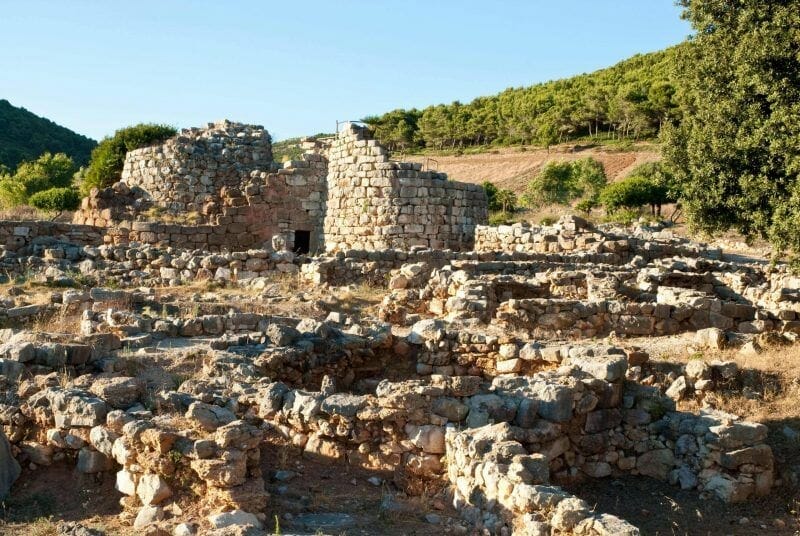
Nuraghe Palmavera
Nuraghe Palmavera dwells in a village that’s almost four thousand years old. Welcome to the extreme northwest of Sardinia – Alghero! The site lies just one and a half kilometers from the sea. Here’s the kicker: contrary to most, this complex was built out of blocks of limestone and tons of sand. Most of the nuraxis in Sardinia were constructed out of basalt, so this is a very unique aspect of Nuraghe Palmavera.
Surrounding the central tower are 50 huts that have been unearthed. However, Nuraghe Palmavera was actually constructed in three stages. During the 15th to 14th century BC, the main tower was built. Then in the 9th century BC, another tower was built, as well as a meeting hut. During a third construction phase in the 9th to 8th century BC, a perimeter wall was erected.
Visiting this nuraghe is an absolute delight as it’s a journey through the ages!
PRACTICAL INFORMATION: The site is open daily from 10:00 am to 7:00 pm. Admission fee is €5; if you also include the necropolis of Anghelu Ruju, the ticket is €8. You can get a guide on the site for €2 per person and if that is what you need make sure to call the site ahead and book a guide in advance. You can also rent an audio-guide for €3.
Check out my post A Guide To Nuraghe Palmavera.
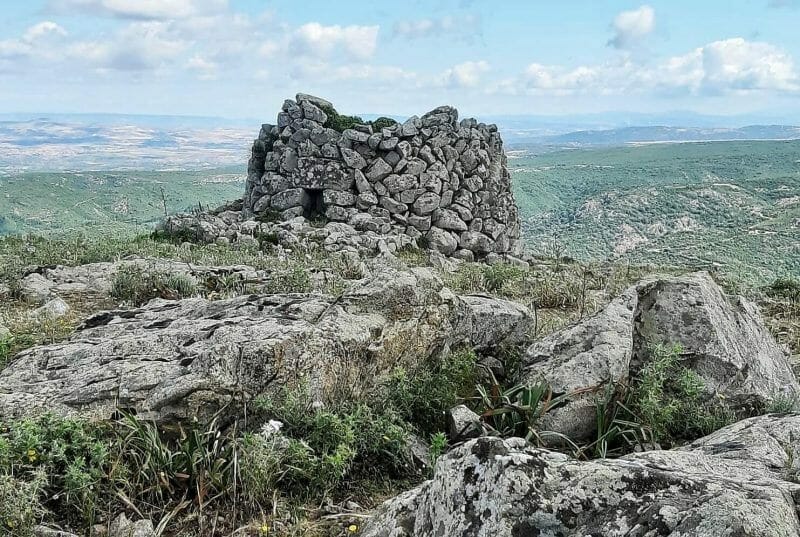
Nuraghe Sa Domu e’ S’Orcu
This nuraxi a bit outside of the historical center Dolianova, in southern Sardinia, dates back to the Bronze era and is one of the best kept in the Parteolla region. It is located on top of a hill that surmounts Riu Murera valley.
It’s a gorgeous panoramic sport which in the past served as a favorable defensive position and which nowadays offers a great experience to anybody who visits. On a clear day, from the nuraxi you can admire the beautiful vineyards of Parteolla, the Gulf of Cagliari and the mountains of Sulcis and, further in the distance, even those of Gennargentu.
PRACTICAL INFORMATION: You can visit this nuraghe independently. There is no admission fee. Much of it has yet to be excavated.
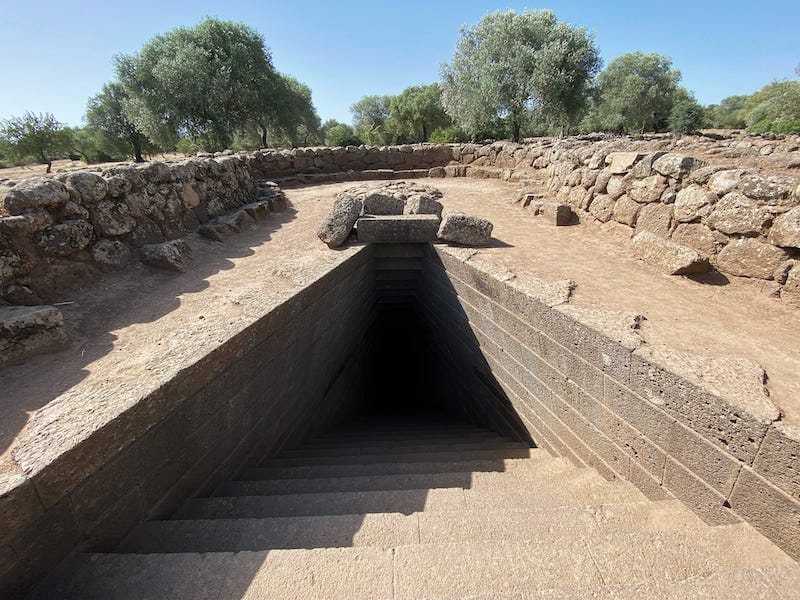
The Sanctuary of Santa Cristina complex
The Sanctuary of Santa Cristina is a mysterious Nuragic temple built in the 12th century BC. It lies in central-western Sardinia near the town of Paulilatino. Fixed around a triangular-shaped deepwater well, this temple was stationed in such a way to reflect the moon during different times of the year.
This is an incredible example of water-temple religious architecture. Laid out almost in a lock-and-key design, circling the well, the Sanctuary of Santa Cristina is truly unique. It’s nearly perfectly balanced, with a specific geometric composition that baffles present-day historians and archeologists.
Actually, there is an 11th-century medieval Christian church – the Church of Santa Cristina – sitting just a few dozen meters from this renowned archeological and sacred site. Although it was built nearly a century later, it is the presence of this church that the Nuragic sanctuary takes its name from.
Even though it isn’t a nuraghe, given the supreme uniqueness of this ancient site, you really shouldn’t miss it!
PRACTICAL INFORMATION: The site is open daily from 8:30 am until dusk. Admission fee is €5. You can visit the site on guided day trips from Cagliari such as this full day tour to Well Temple and Cabras museum.
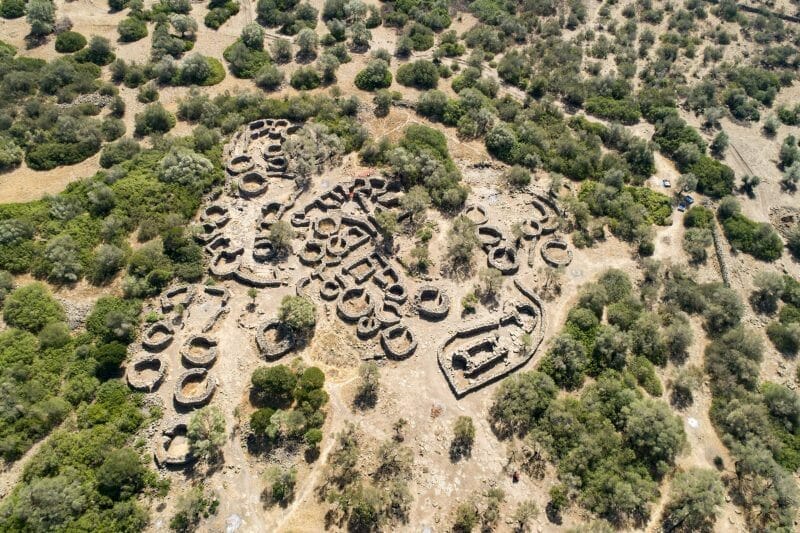
Nuraghe Serra Orrios
Nuraghe Serra Orrios is a fantastic Nuragic complex situated in the municipality of Dorgali, in the province of Nuoro in central-eastern Sardinia. Perched on a plateau that overlooks the sea, and surrounded by hills and thousand-year-old olive trees, Serra Orrios is quite the sight to behold!
Comprised entirely of basalt blocks, this complex was specifically designed as a proto-urban settlement. You can see a great number of civil and cultural structures from the Nuragic period, as well as a village of nearly 100 huts! The huts are grouped into three blocks, all of which are connected by streets. There are also two giant tombs and two temples to check out. There are many preserved ceramic and metal artifacts to view from village life in the tail-end of the Bronze Age, from bowls and bracelets to jugs and chisels!
PRACTICAL INFORMATION: The site is open daily from 9:00 am to 5:00, 6:00 or 7:00 pm depending on the season. Admission fee is €5.

Giants of Mont’e Prama
The Giants of Mont’e Prama are ancient Nuragic sculptures of isolated humanoid figures. They were first found in central-western Sardinian, in Mont’e Prama in Sinis di Cabras (from which they take their name). The sculptures are made of sandstone and stand between 2 to 2.5 meters tall.
When these statues were discovered, a total of 5,178 fragments were found — 15 heads, 27 busts, and more than 300 arm and leg fragments.
The Giants of Mont’e Prama sculptures had to be reconstructed from fragments until 38 sculptures were restored — six archers, six warriors with shields and swords, sixteen boxers, four unrecognized forms, and thirteen models of nuraghe.
However, two figures were found that are hypothesized to be priests or magicians. Curiously, one of the key differences between these two statues and all the others is the fact that they are wearing shoes and peculiar cone-shaped head ornaments.
What is most shocking is the refined nature of these statues: they are unique, complex, and impressive. These statues testify to the artistic skills of the Nuragic people during the Bronze Age. Not only could this ancient civilization construct astonishing architectural feats with their nuraghe, but they also had a refined artistic streak. As a matter of fact, these statues are the oldest statues of this size to be discovered in the entire Mediterranean basin.
PRACTICAL INFORMATION: You can see the Giants of Mont’e Prama at the Archeological Museum of Cagliari on your visit to Sardinia, or at Cabras Museum of Archeology. The latter one is open daily from 10:00 am to 6:00 pm. Admission fee is €6.50.

Final Thoughts on Which Nuraghe Sites Are Worth Visiting
So, did I sufficiently answer your question — which Nuraghe should I visit? I hope so! It was hard to select the top Nuragic sites to visit since there are 7,000 to choose from. However, these nine ancient archeological wonders really do stand out above all the rest.
From the unique geometric design of the Sanctuary of Santa Cristina to the Nuraghe Losa that almost looks like the bow of a ship, these are mythical archeological gems from the ancient world. I wouldn’t be surprised to see Indiana Jones unearthing some hidden treasure from their depths!
If you have visited Sardinia’s Nuraghe and want to share your story with me, I’m all ears! Please post a comment below. I’d love to hear what you liked the most about these sites.
Further Readings
Make sure to read my other posts about Sardinia:
- The History Of Sardinia And Where To Discover It
- The Most Interesting Archeological Sites In Sardinia
- What You Should Know Before Traveling To Sardinia
- 10 Absolutely Unmissable Things To Do In Sardinia
- The 12 Best Museums In Sardinia
- The Most Beautiful Churches in Sardinia
- The 15 Best Beaches In Sardinia
- The Most Incredible Day Trips From Cagliari
- A Guide To Sardinian Wines
- The Most Delicious Sardinian Food: Everything You Must Try
- A Complete Guide To Costa Smeralda
- The Nicest Small Towns And Cities In Sardinia
- The Most Beautiful Beach Resorts In Sardinia
- The Most Captivating Castles In Sardinia
- 9 Sardinian Mines You’ll Enjoy Visiting
Pin It For Later!
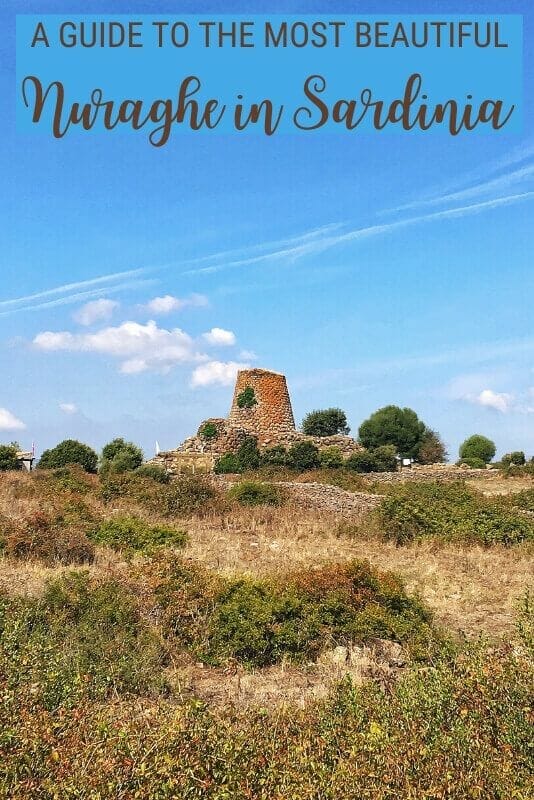

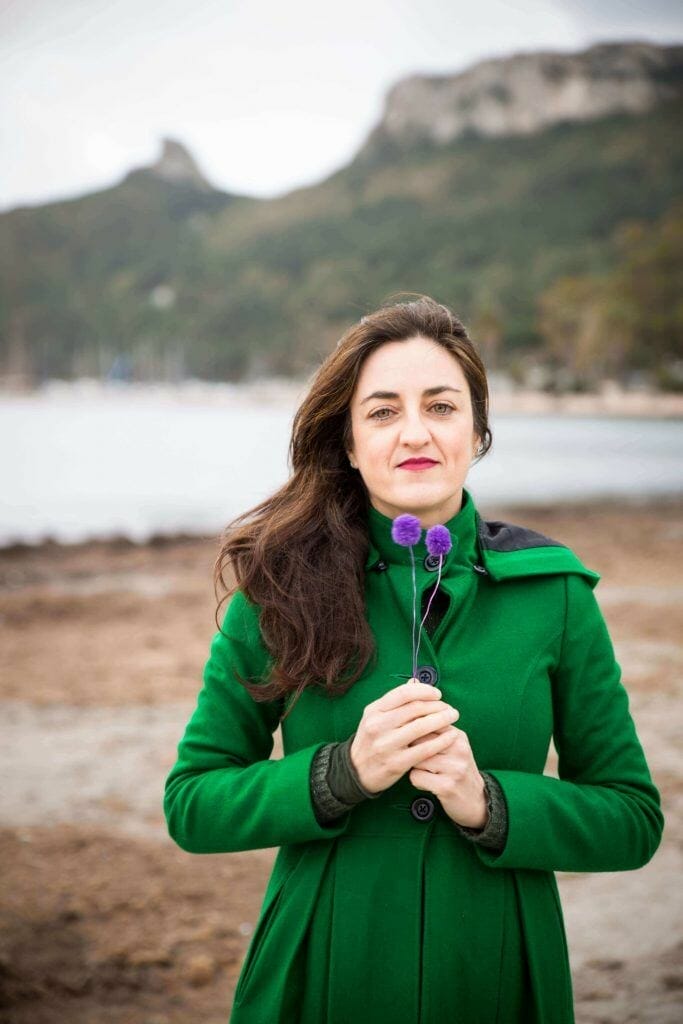
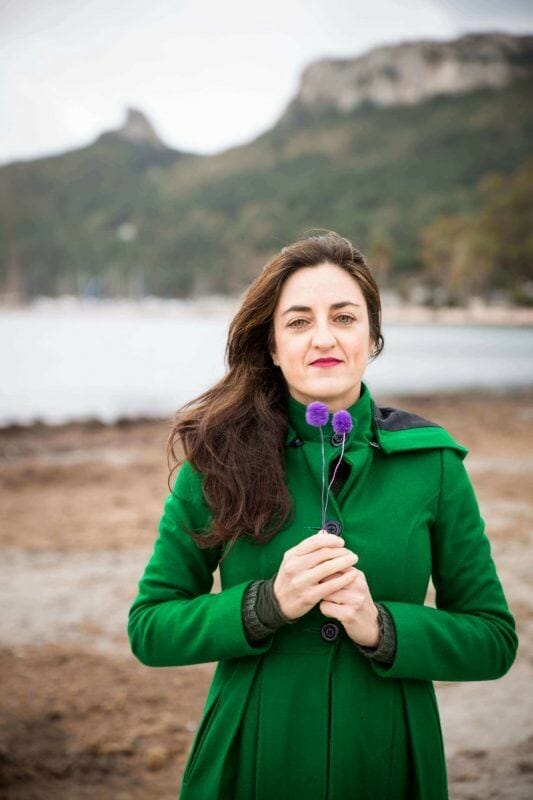

I had the pleasure of visiting Sardegna some years ago. Most impressed I was by the Nuraghi structures, of which the Nuraghi Losa stood out. So amazing. But a real mystery is troubling me, what is the connection between the Nuraghi forts in Sardegna and the Brochs of Scotland? I live near such Brochs on the west coast of Scotland and the designs are almost identical. And both countries (Scotland, UK and Italy) lay claim to being the only place in the world where these buildings exist. Help me solve this mystery.
Oh I wish I knew. I think you are better off contacting an archeologist on the matter!